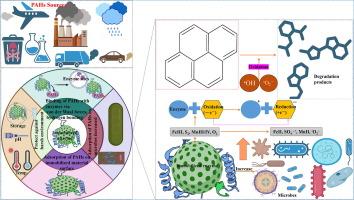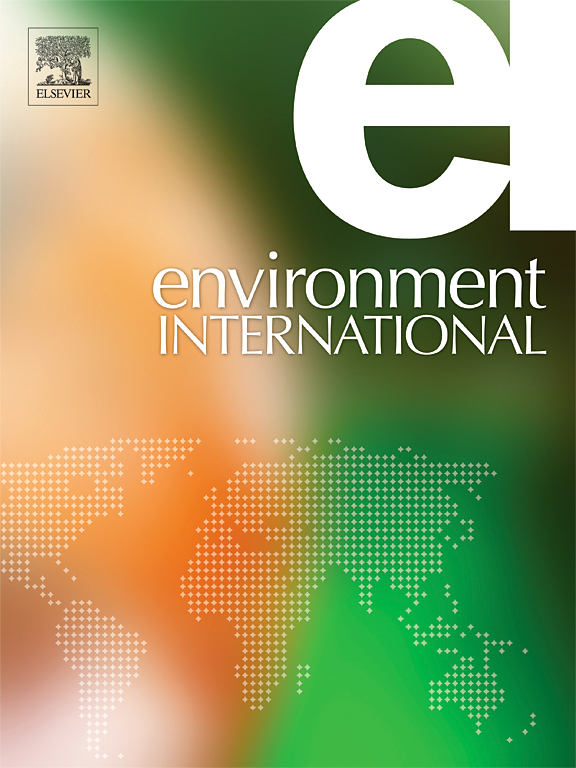Evaluation of the immobilized enzymes function in soil remediation following polycyclic aromatic hydrocarbon contamination
IF 10.3
1区 环境科学与生态学
Q1 ENVIRONMENTAL SCIENCES
引用次数: 0
Abstract
The bioremediation of polycyclic aromatic hydrocarbon (PAHs) from soil utilizing microorganisms, enzymes, microbial consortiums, strains, etc. has attracted a lot of interest due to the environmentally friendly, and cost-effective features. Enzymes can efficiently break down PAHs in soil by hydroxylating the benzene ring, breaking the C–C bond, and catalyze the hydroxylation of a variety of benzene ring compounds via single-electron transfer oxidation. However, the practical application is limited by its instability and ease to loss function under harsh environmental conditions such as pH, temperature, and edaphic stress etc. Therefore, this paper focused on the techniques used to immobilize enzymes and remediate PAHs in soil. Moreover, previous research has not adequately covered this topic, despite the employment of several immobilized enzymes in aqueous solution cultures to remediate other types of organic pollutants. Bibliometric analysis further highlighted the research trends from 2000 to 2023 on this field of growing interest and identified important challenges regarding enzyme stability and interaction with soil matrices. The findings indicated that immobilized enzymes may catalyzed PAHs via oxidation of OH groups in benzene rings, and generate benzyl radicals (i.e., •OH and •O2) that undergo further reaction and release water. As a result, the intermediate products of PAHs further catalyze by enzyme and enzyme induced microbes producing carbon dioxide and water. Meanwhile efficiency, activity, lifetime, resilience, and sustainability of immobilized enzyme need to be further improved for the large-scale and field-scale clean-up of PAHs polluted soils. This could be possible by integrating enzyme-based with microbial and plant-based remediation strategies. It can be coupled with another line of research focused on using a new set of support materials that can be derived from natural resources.

评估固定化酶在多环芳烃污染后土壤修复中的功能
利用微生物、酶、微生物联合体、菌株等对土壤中的多环芳烃(PAHs)进行生物修复因其环境友好和成本效益高的特点而备受关注。酶可以通过羟化苯环、断裂 C-C 键来有效分解土壤中的多环芳烃,并通过单电子转移氧化催化多种苯环化合物的羟化。然而,由于其不稳定性以及在 pH 值、温度和土壤胁迫等恶劣环境条件下容易丧失功能,其实际应用受到了限制。因此,本文重点关注用于固定酶和修复土壤中多环芳烃的技术。此外,尽管在水溶液培养物中使用了几种固定化酶来修复其他类型的有机污染物,但以往的研究并未充分涵盖这一主题。文献计量学分析进一步强调了从 2000 年到 2023 年这一人们日益关注的领域的研究趋势,并确定了有关酶稳定性和与土壤基质相互作用的重要挑战。研究结果表明,固定化酶可通过氧化苯环中的羟基催化多环芳烃,并生成苄基自由基(即-OH 和-O2),这些自由基会发生进一步反应并释放出水分。因此,多环芳烃的中间产物在酶和酶诱导微生物的催化下进一步产生二氧化碳和水。同时,固定化酶的效率、活性、寿命、复原力和可持续性也需要进一步提高,以便大规模和实地净化多环芳烃污染的土壤。这可以通过将基于酶的方法与基于微生物和植物的修复策略相结合来实现。同时,还可以开展另一项研究,重点是使用一套可从自然资源中提取的新辅助材料。
本文章由计算机程序翻译,如有差异,请以英文原文为准。
求助全文
约1分钟内获得全文
求助全文
来源期刊

Environment International
环境科学-环境科学
CiteScore
21.90
自引率
3.40%
发文量
734
审稿时长
2.8 months
期刊介绍:
Environmental Health publishes manuscripts focusing on critical aspects of environmental and occupational medicine, including studies in toxicology and epidemiology, to illuminate the human health implications of exposure to environmental hazards. The journal adopts an open-access model and practices open peer review.
It caters to scientists and practitioners across all environmental science domains, directly or indirectly impacting human health and well-being. With a commitment to enhancing the prevention of environmentally-related health risks, Environmental Health serves as a public health journal for the community and scientists engaged in matters of public health significance concerning the environment.
 求助内容:
求助内容: 应助结果提醒方式:
应助结果提醒方式:


